China # 6 – Turpan – Heading east along the Northern Taklamakan Desert – September 2014
After a short drive from the Gaochang ruins we arrived in the pleasant city of Turpan. Turpan is China’s “Death Valley”. Part of the Turpan basin is 154m, (505 feet), below sea level, making it the second lowest depression on earth, just after the Dead Sea. It is the hottest spot in China. In July and August, temperatures soar above 40°C and even 50°C, (120°F), forcing the local population to sleep on their roofs.
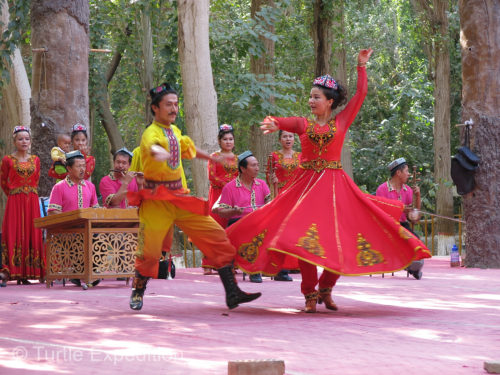 We arrived in the heat of a summer afternoon to visit the Turpan Museum, a wonderful collection of over 7,000 exhibits including cultural relics with examples of pottery, bronze copper and textiles dating back to the Silk Road civilizations of the Greek-Roman, Ancient China, Persian-Arabian, and the Nomadic peoples of the Eurasian Steppe.
We arrived in the heat of a summer afternoon to visit the Turpan Museum, a wonderful collection of over 7,000 exhibits including cultural relics with examples of pottery, bronze copper and textiles dating back to the Silk Road civilizations of the Greek-Roman, Ancient China, Persian-Arabian, and the Nomadic peoples of the Eurasian Steppe.
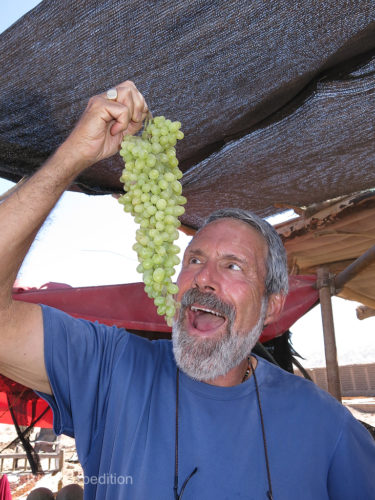 To give cooling shade during the intense summers, many streets in the nearby villages are covered with grapevine trellises. Despite the heat, the ground water and fertile soil of the Turpan depression has made this a veritable oasis in the desert. An amazing sophisticated irrigation system known as the Karez brings irrigation water from the surrounding mountain ranges from the annual melting of the snow. The Karez System consists of wells, underground channels, ground canals, and small reservoirs, which use the natural slope of the terrain to sustain the water flow and guide the water right to the plants while minimizing evaporation. California could learn something here. Just under 1,000 canals with a total length of about 5,000 km (3,100 mi), the system is considered one of the three great ancient projects in China along with the Great Wall and the Grand Canal.
To give cooling shade during the intense summers, many streets in the nearby villages are covered with grapevine trellises. Despite the heat, the ground water and fertile soil of the Turpan depression has made this a veritable oasis in the desert. An amazing sophisticated irrigation system known as the Karez brings irrigation water from the surrounding mountain ranges from the annual melting of the snow. The Karez System consists of wells, underground channels, ground canals, and small reservoirs, which use the natural slope of the terrain to sustain the water flow and guide the water right to the plants while minimizing evaporation. California could learn something here. Just under 1,000 canals with a total length of about 5,000 km (3,100 mi), the system is considered one of the three great ancient projects in China along with the Great Wall and the Grand Canal.
Farming in the Turpan Basin is particularly famous for its fruit production, especially grapes. Because of the dry and hot conditions, the fruits grown in the depression have very high concentrations of sugar. They are traditionally processed by drying in open drying barns. The cultivated fruit include mulberry, peach, apricot, apple, pomegranate, pears, fig, and more than 100 varieties of grapes.
Green, (our trusted guide), was good at keeping us away from tourist traps, but the Grape Valley Amusement Park and the annual Grape Festival in a nearby village sounded interesting. Indeed, we arrived just in time to watch a talented group of musicians and folk dancers. Monika was invited to join them while I was busy taking photos. There were small shops selling souvenirs and special musical instruments. We really had to laugh at all the signs, especially those about the bathrooms. You must read them! (see photos).
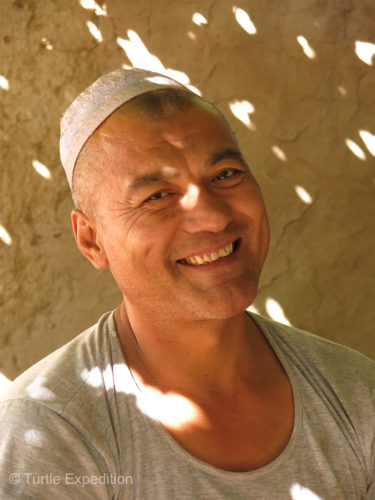
This friendly farmer suggested we should buy a particular raisin because they were particularly healthy for “old” folks. Hm.
Walking back to our truck, which was probably parked illegally, we were admiring the beautiful art on the doors of homes when a man approached us and insisted we come in for tea. We accepted and he humbly explained to our guide that he, (obviously Muslim because of the area), just wanted to tell us and show us he and his family were not terrorists. He gave us an interesting tour of his home, including his vineyard, his stable of goats, and his irrigation channel that was most likely part of the Karez System. We met his mother and his wife and were treated to some appreciated tea and fruit. It was a refreshing experience and we thanked him many times.
Back on the main promenade there were many stands selling the fresh and dried fruits of the area, including piles of sweet raisins and grapes. The first place we stopped, the owner, a gregarious guy, also invited us in to see how the grapes are hung and naturally air dried, a very interesting process. He explained that one kind of particularly big and wonderful tasting raisins would be most beneficial to us and when questioned why, he smiled and said that variety was good for “old” folks. Hm. We were good customers and stocked up on several raisin varieties for the rest of the trip and gifts, knowing that we would never see any better.
- No, these were not condos nor mausoleums. They were drying building for grapes and other fruit.
- The new Turpan Museum had over 7,000 exhibits.
- The new Turpan Museum.
- A grandiose entrance to the new Turpan Museum.
- Some of the old wood, reed and leather pots had been found during various excavations in the area.
- This painting depicted exactly what we were about to see next.
- This was an interesting photograph of women preparing Chinese noodles.
- To give cooling shade during the intense summers, many streets were covered with grapevine trellises. The sign read, “Ornamental Grapes, Do Not Pick”.
- The grapes on the trellis along the walkways were tempting.
- Arriving at the Grape Valley Amusement Park, there was another small exhibit of artifacts and art.
- Talented musicians were playing traditional instruments while dancers sang folk songs.
- We thoroughly enjoyed the dancers as they spun and twirled across the stage.
- These were the star dancers.
- Monika needed a picture with her favorite dancer, a handsome young guy.
- Monika was invited to join the dance group.
- I had my favorite too, and she knew I was watching her.
- There were small shops selling souvenirs and special musical instruments, some the same as those being played by the dance group.
- Yes, we are still into the amazing colors and fashion we saw in Kashgar.
- The park buildings were beautiful.
- We wondered what a person was to do if they wanted to smoke?
- As we became more aware of Chinese toilets we kept a sharp eye out for these 4-star Tourist Toilets.
- Bathroom facilities were star rated in China. Always head for the 4 or 5 star ones if you can.
- “Close to civilization and convenience”
- We guess urinals were a new idea for Chinese tourists.
- Oh yes, even a sit-down toilet—Special for the old. I was old enough.
- 4 and 5 star bathroom facilities offer a sit-down toilet. Lower numbers are squatters.
- “Standard for civilized answering the call of nature.” I like #2. Don’t pee on the floor.
- As we wandered through town under the shade of the grape trellises, we admired the are on the doors of homes.
- We enjoyed the various painted entrances.
- Inside these doors, life goes on.
- A creative way to keep a baby bassinet off the floor.
- No, I was not picking.
- Outside beds were the norm in the summer heat. Some homes supposedly even have underground rooms to escape the intense heat.
- This irrigation channel may have been part of the Karez water transfer system.
- Wish I had a broom like this at home.
- Kitchen, bedroom and dining room all outside in the cool air.
- Reed mats and grape vine covered trellises offered much appreciated shade.
- This is a typical Uygur sitting area.
- Hot tea and fresh fruit was a welcome treat.
- We were easily convinced that our host’s mother was not a terrorist.
- The Jinpin seem to be a popular motorcycle in China.
- Who are these strangers walking around my backyard?
- We had never seen so many different kinds of raisins. Over 100 varieties of grapes are cultivated in Turpan.
- Raisins, raisins and more raisins…..
- It was really hard to choose from so many varieties of raisins.
- Raisins anyone? Take your pick.
- Plump dried prunes were a special treat.
- We had seen dried melon on the road side but never tried it.
- We bought more grapes that the three of us could eat. So many choices.
- No mechanical harvesting here. I could barely walk through this vineyard.
- These unique buildings are where grapes and other fruit are dried, out of the direct sunlight.
- Grapes are hung on these racks and suspended inside the drying buildings.
- A unique system for producing some of the best raisins in the world.
- This gregarious farmer was happy to show us how he dried his grapes.
- This friendly farmer suggested we should buy a certain raisin because they were particularly healthy for “old” folks. Hm.
- Another dining experience with our foodie guide.
- Yes, the chicken foot is part of a chicken stew.
- Green said chicken feet were the best part. We gave ours to her.
- Green’s hotel for the night was a step above her MSR tent in a gravel pit. Deluxe, with AC, hot water, TV and even a mini bar.
- The bathroom looked nice and modern.
- Our “hotel” for the night was peaceful in the hotel parking lot. The sweltering heat prompted us to stay in the hotel for the second night.
- These strange looking greenhouses were probably very efficient for the extreme temperatures of the desert.
- The plants inside these green houses are protected from sweltering heat and icy cold winds.
- No, we did not need more grapes—–well, maybe just a few for the road.
- Alongside the toll road we could see “mole” mounds which are access holes to the underground irrigation tunnels of the amazing Karez System for periodic cleaning and maintenance.
- These monster Chinese over-the-road semi-trucks have as many as 12 axles and 20 wheels on the ground. Water-cooled brakes are a help.
- At times, oil rigs were pumping away.
- At other times, a forest of wind generators was in the process of being erected.



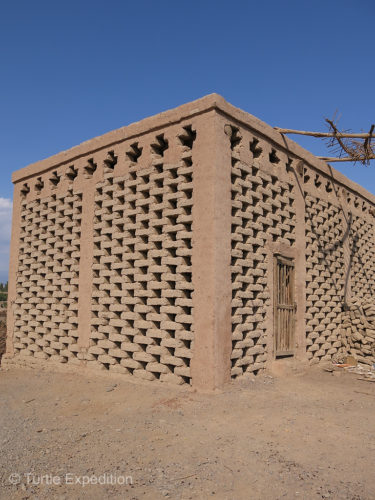
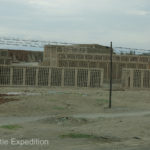
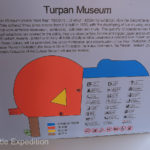
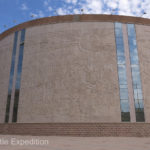
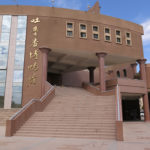
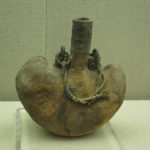
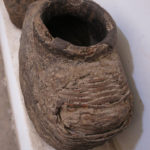
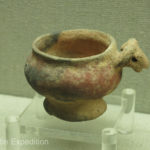
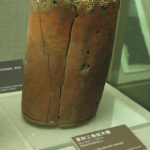
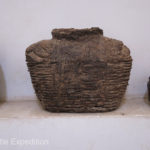
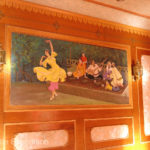
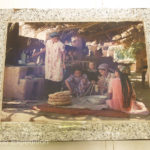
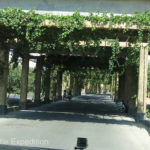
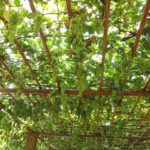
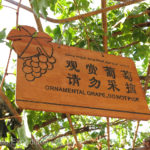
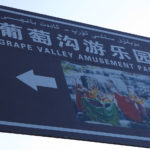
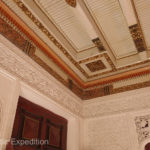
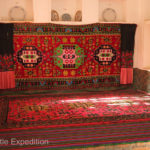
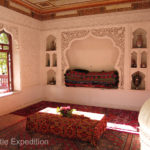
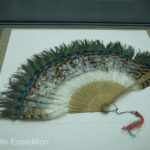
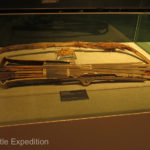
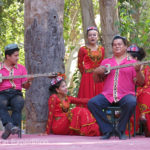
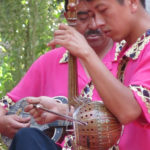
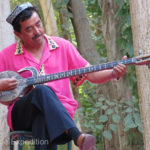
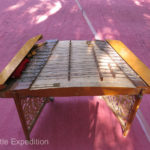
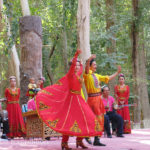
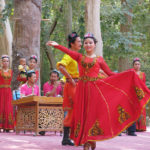
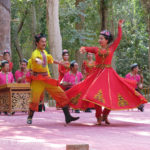
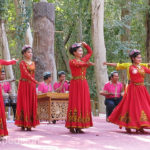
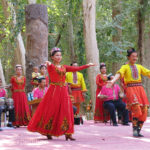
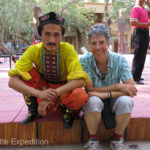
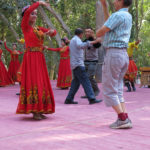
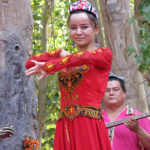
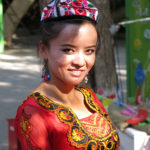
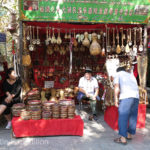
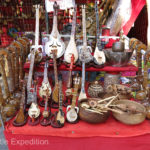
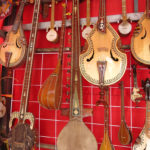
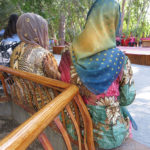
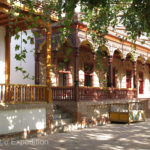
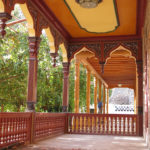
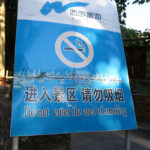

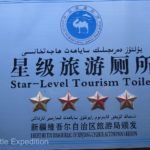
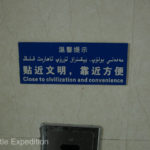
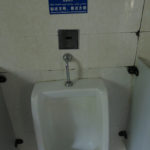
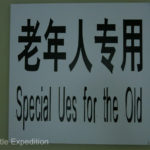
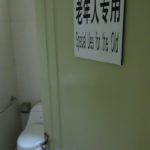
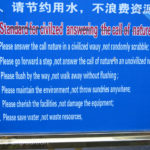
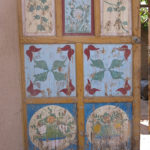
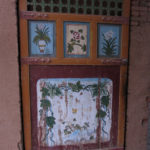
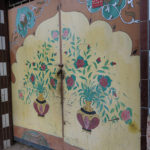
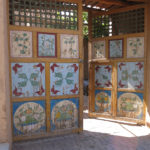
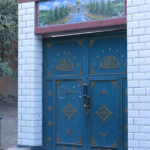
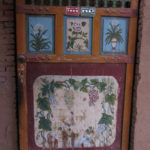
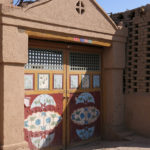
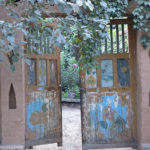
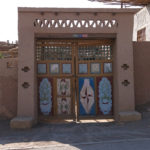
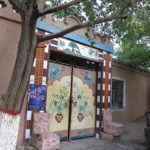
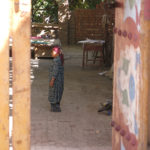
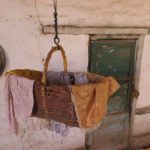
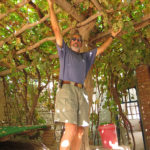
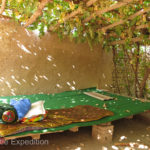
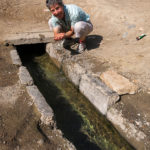
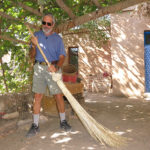
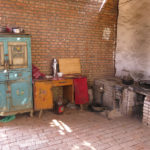
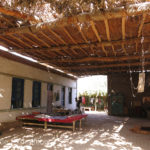
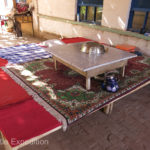
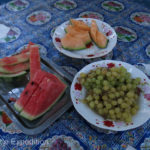
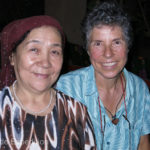
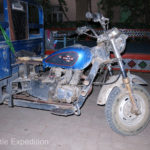
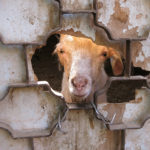
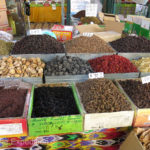
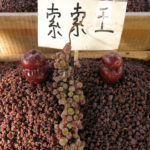
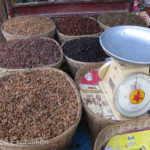
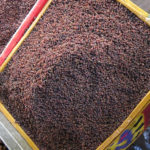
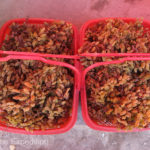
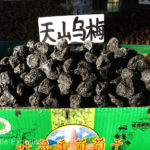
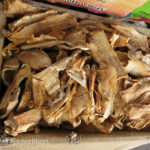
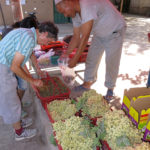
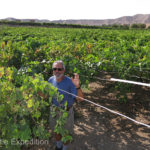
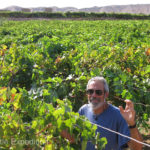
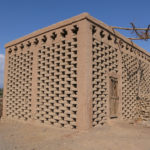
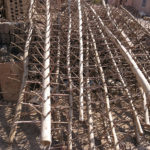
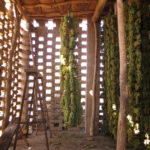
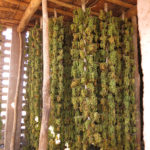
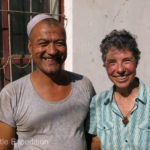
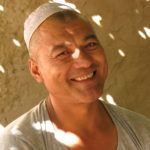
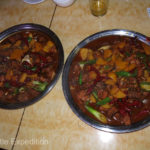
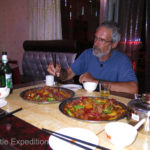
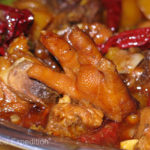

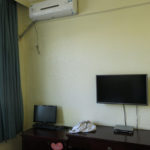
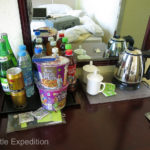
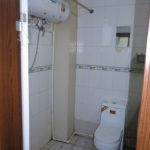
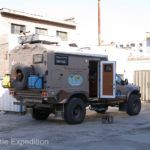
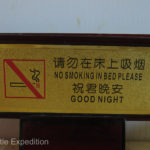
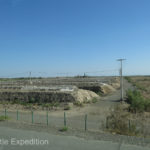
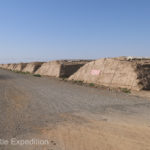
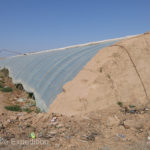
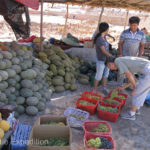
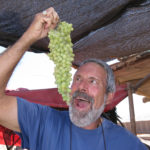
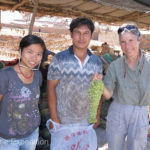
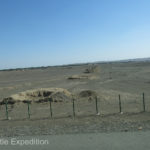
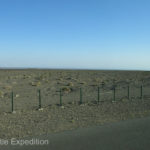
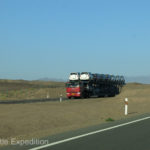
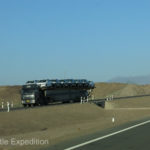
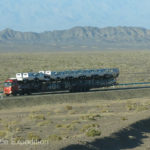
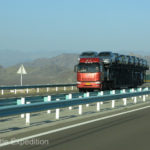

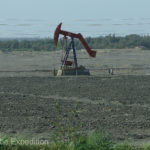
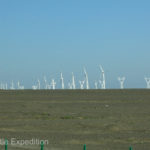
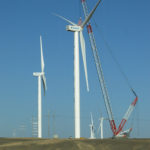
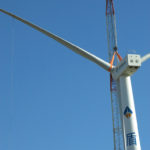





Very interesting! China is full of wonderment.
So true!